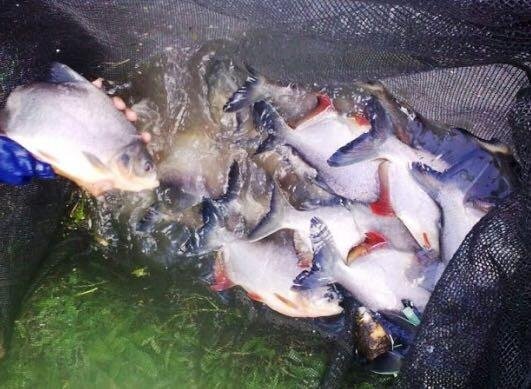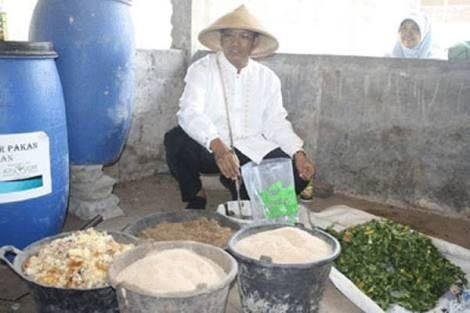Feeding Guide of Pomfret Fish
Feed / food for aquaculture in the tarpaulin pond is fully derived and a cultivator. Feeding is a routine activity that is not only constantly done, but also absorb considerable production costs. Costs typically reach more and 60% and production costs.

In order to use the feed more efficiently and keep the fish environment optimally, the best feeding technique needs to be applied. In principle the purpose of applying the feeding technique is to squeeze as little as possible wasted food, in order to obtain a large profit. There are five things that need to be paid attention in giving fish feed, that is giving way, moment or time of giving, amount (portion) of feed, frequency and place of feeding.

1. Ways of Giving
Feeding can be done in two ways, which is spread directly by hand or using a tool such as a bucket or can with a conical bottom and serves as a semi-automatic feeding tool. Semi-automatic feeding tool (pepakan) is called the demand feeder that works on the basis of the touch power of the fish. Automatic feeding tool called automatic feeder that works using electric power and feed disbursement can be arranged.
Each of the above has advantages and weaknesses. The weakness of the use of pellets (demand feeder), among others, is the distribution of uneven pellets grains for all fish. The area around the stick will be dominated by large fish so that there will be differences in growth between large fish and small fish. The longer the maintenance, the greater the difference. As a result, the weight of fish during the harvest was varied. Another disadvantage is, the fish likes to "fad" touch the handle of the pellets so the pellets still fall while the fish is full. However, the use of this tool saves time and effort.
The use of automatic feeder tool is better than pepakan. Some tools can be placed above the surface of the pond water. In accordance with the time specified, the pellet will come out in a certain amount. This tool can be adjusted so that the pellets out evenly on the surface of the pond.
The disadvantage, in addition to using electric power, when preoccupation with using this tool, then the appetite of fish less observed.
Spreading the feed manually by hand evenly in small amounts so that each grain of pellets can be eaten fish, considered better. By using the hand then when the fish looks full, feeding can be stopped immediately. Thus, the feed becomes less wasted, which can accelerate the accumulation of organic matter at the bottom of the pond.
2. Giving Time
Time or time of feeding can be done in the morning, afternoon, evening or evening, but usually the frequency is different. Regular feeding time aims to discipline fish meal times. Generally fish that are usually given the feed in the morning or evening, the fish will feel hungry in the morning or afternoon as well. Likewise with fish fed on day or night, the fish will need to feed on day and night. So by getting used to feeding at the right time and regularly, fish appetite can be known. Of course the feed becomes more efficient because the feed given directly dilahap out.
3. Amount of Feed
The amount of feed is the portion or the amount of feed needed and should be given to the fish. Usually calculated in percent (%) per day weight (weight) of the total number of fish in the pond. The percentage of feed for fish should be taken care of, do not stick to one standard. Sometimes the benchmark is not very precise because at a certain age or size it takes the amount or portion of the different feed.
BAT fish need 3-4% feed per total weight of fish in the pond, depending on the size of the fish. For BAT size 5-20 g, feed is 4 96 body weight / day or until all the fish do not eat anymore (all fish have been full), while fish size 20 g up, feed given enough 3 96 body weight /day. The feed given should be of good quality and contain 25-27% protein.
It is recommended that every week or every two weeks the cultivator observes the amount of feed needed per biomass weight (fish), Observation can be done while feeding the fish. Way, if the fish already looks full, feeding is stopped, and calculate the number of pounds of feed given in a day (A). Then catch some sample fish (10-15 fish), then calculate the average weight. By multiplying the weight of the average fish by the total number of fish in the pond, we can calculate the total weight of the fish in container (B). Furthermore, with the formula A / B x 100% can know the percentage of feed that must be given / needed (C%).
As long as the feeding portion is fixed, the fish may be fed with a C% portion and the total weight of the fish. But the next weeks the portion of the feed changes up or down the portion of the given feed must also be changed according to the increase and decrease. For experienced fishers or technicians, the amount of feed for fish is always based on when the fish look full (stopped about 15 minutes after the fish will not eat).
4. Frequency of Giving
Frequency of feeding is the frequency of feeding time in a day, can be 1 time, 2 times, 3 times, 4 or more often. Generally the frequency of fish feed intensive system maintained is between 3-5 times a day.
The frequency of feeding is related to the frequency of fish hunger. But sometimes the frequency of feeding intentionally arranged to spur the growth of fish. The assumption is, feeding gradually but with frequent frequencies help the fish to not get satiated and the appetite of fish is maintained. Thus, the amount / portion of feed eaten fish can be more so that the growth of fish become
5. Place of Giving
Place of feeding is the location or position of the feed should be given. The feed can be fed to one place, for example near a water intake channel only or in some places. In addition to ensuring that all fish are getting enough food in the right portion, the proper feeding location is also intended to make the amount of feed given efficiently.
Fish always remember the time and place where each feed is fed. Therefore, the fish will wait at the feeding site when the feeding time comes. By disciplining the fish while feeding, both time and place, the feed can be utilized eficiently.
In order to provide efficient feeding, the fish environment (no stockfilling at the bottom of the pond) remains good, production costs can be suppressed, and to avoid greater losses, proper fish feeding techniques should be truly done. and the place where each feed is fed. Therefore, the fish will wait at the feeding site when the feeding time comes. By disciplining the fish while feeding, both time and place, the feed can be utilized eficiently.
In order to provide efficient feeding, the fish's living environment (no stockfilling at the bottom of the pond) remains good, production costs can be reduced, and to avoid greater losses, proper fish feeding techniques should really be done.
Posted by: Mas Anto / January 3, 2015 On Bawal Fish Cultivation Source: https://www.banyudadi.com/pemberian-pakan-ikan-bawal/